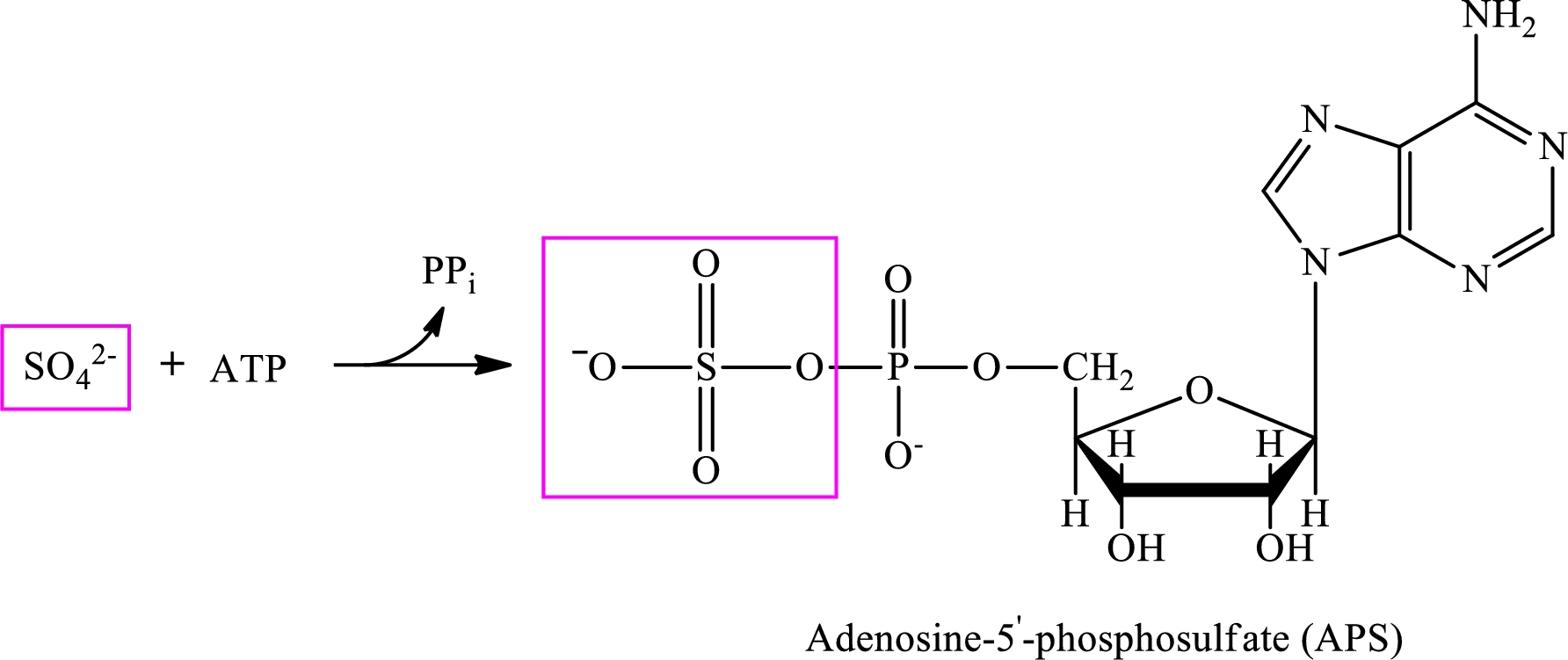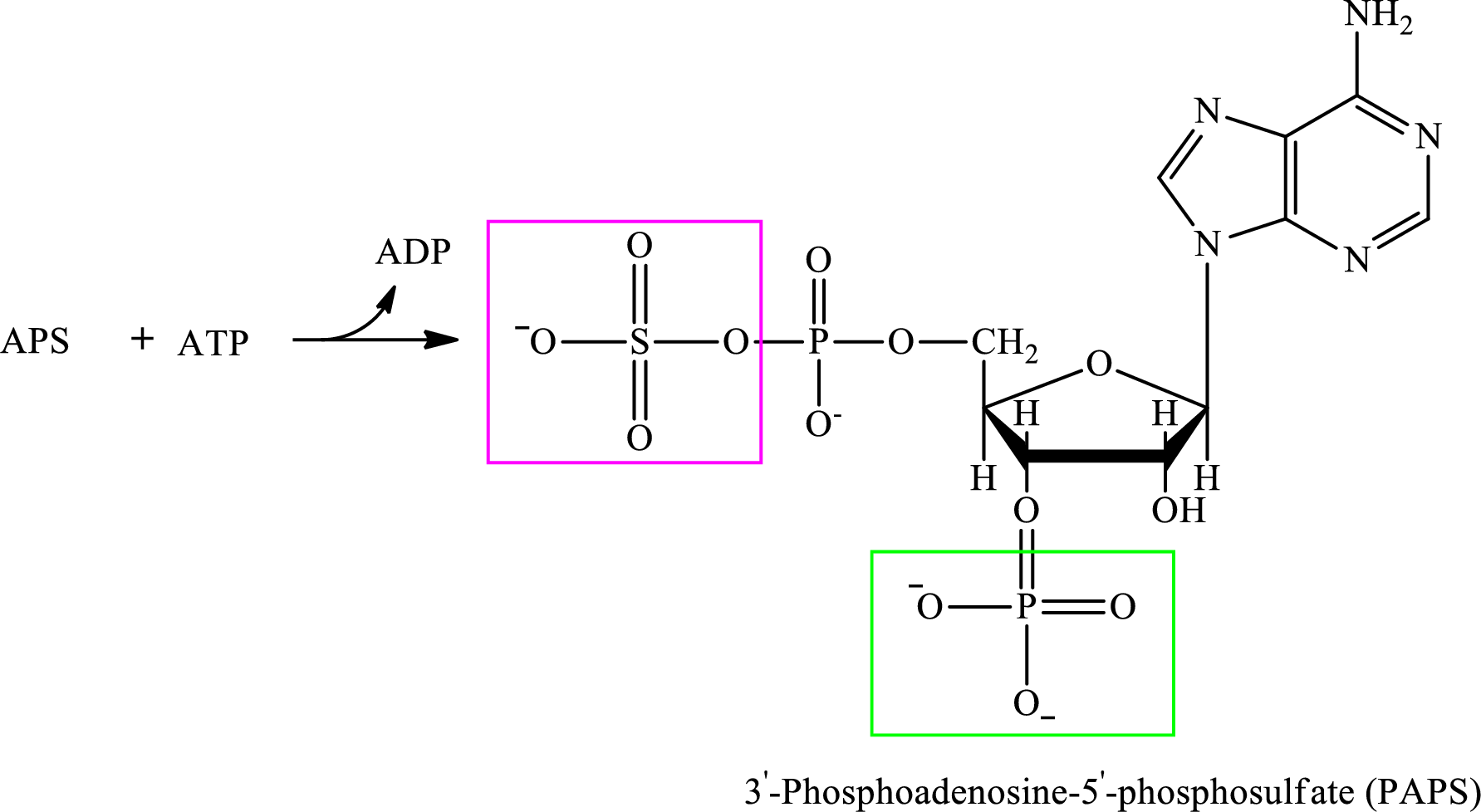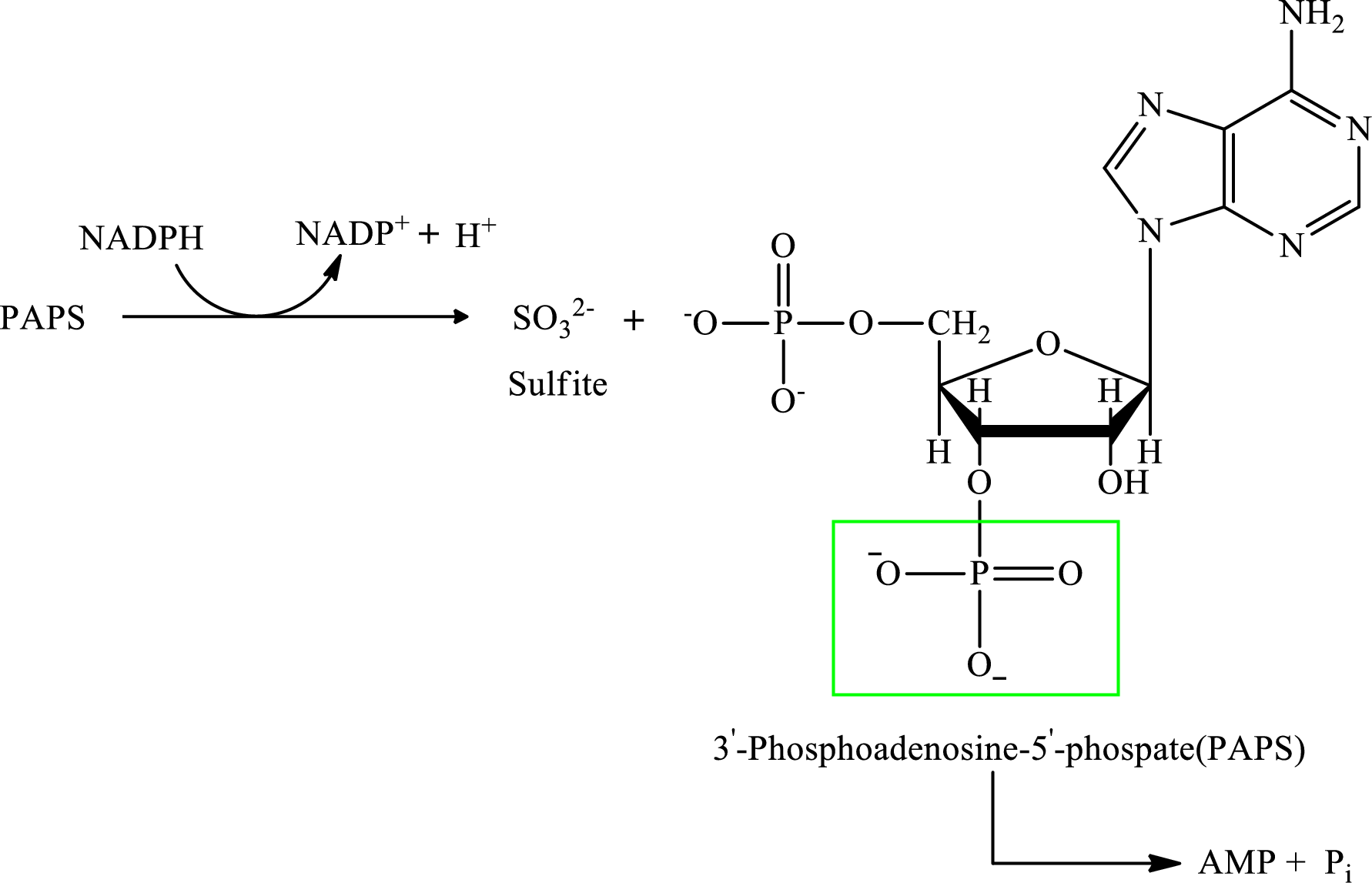
EBK GENERAL, ORGANIC, AND BIOLOGICAL CH
7th Edition
ISBN: 8220100853180
Author: STOKER
Publisher: CENGAGE L
expand_more
expand_more
format_list_bulleted
Concept explainers
Question
Chapter 26.8, Problem 3QQ
Interpretation Introduction
Interpretation: To determine the reactant in the first step of the sulfate assimilation process.
Concept introduction: Sulfate assimilation is the process used for the production of hydrogen sulfide. The starting material for sulfate assimilation is sulfate ion. It is an oxidation-reduction process as the sulfur in sulfate ion is in oxidized form and in hydrogen sulfide it is present in the reduced form.
The conversion of sulfate ion to sulfide ion via sulfate assimilation occurs in 4 steps. These steps are as follows:
Step 1:

Step 2:

Step 3:

Step 4:

Expert Solution & Answer
Want to see the full answer?
Check out a sample textbook solution
Students have asked these similar questions
show the retrosynthesis of this
molecule step by step starting with
1,3-dimethoxy benzene
H3CO
OH
OH
OCH 3
Consider the reaction of a propanoate ester with hydroxide ion shown below. A
series of four alcohol leaving groups were tested to determine which would be the
best leaving group.
Based on the pKa values of the alcohols, predict which alcohol would produce the
fastest hydrolysis reaction.
HO
FOR
A
Alcohol I, pKa =16.0
B
Alcohol II, pKa =10.0
C
Alcohol III, pKa = 7.2
+ ROH
D
Alcohol IV, pKa = 6.6
Curved arrows are used to illustrate the flow of electrons. Using
the provided starting and product structures, draw the curved
electron-pushing arrows for the following reaction or
mechanistic step(s).
Be sure to account for all bond-breaking and bond-making
steps.
:0:
NaOH, H₂O
00:4
Na O
heat
NaO
Select to Add Arrows
Select to Add Arrows
:0:
Na
a
NaOH, H2O
:0:
NaOH,
H2O
heat
heat
Na
ONH
Select to Add Arrows
Chapter 26 Solutions
EBK GENERAL, ORGANIC, AND BIOLOGICAL CH
Ch. 26.1 - Which of the following statements about dietary...Ch. 26.1 - Dietary protein materials as they leave the...Ch. 26.1 - The inactive form of pepsin is converted to its...Ch. 26.1 - Which of the following is not a proteolytic...Ch. 26.2 - The dominant use for the amino acids of the amino...Ch. 26.2 - The most abundant amino acid in the amino acid...Ch. 26.2 - Prob. 3QQCh. 26.3 - Prob. 1QQCh. 26.3 - Prob. 2QQCh. 26.3 - The net effect of transamination is to collect the...
Ch. 26.3 - Prob. 4QQCh. 26.3 - Prob. 5QQCh. 26.3 - Most aminotransferases are specific for the keto...Ch. 26.4 - Which of the following statements concerning the...Ch. 26.4 - Prob. 2QQCh. 26.4 - The two fuels for the urea cycle are a. carbamoyl...Ch. 26.4 - Prob. 4QQCh. 26.4 - Prob. 5QQCh. 26.4 - Prob. 6QQCh. 26.5 - Which of the following statements concerning the...Ch. 26.5 - Prob. 2QQCh. 26.5 - Prob. 3QQCh. 26.5 - Prob. 4QQCh. 26.6 - Prob. 1QQCh. 26.6 - How many of the standard amino acids are...Ch. 26.6 - The simplest pathways for amino acid biosynthesis...Ch. 26.7 - Prob. 1QQCh. 26.7 - Which of the following statements concerning the...Ch. 26.7 - Prob. 3QQCh. 26.7 - In the degradation of heme, the iron atom present...Ch. 26.8 - In degradation of the sulfur-containing amino acid...Ch. 26.8 - Prob. 2QQCh. 26.8 - Prob. 3QQCh. 26.8 - Prob. 4QQCh. 26.9 - Prob. 1QQCh. 26.9 - Prob. 2QQCh. 26.9 - Prob. 3QQCh. 26.10 - Prob. 1QQCh. 26.10 - Prob. 2QQCh. 26.10 - Prob. 3QQCh. 26 - Prob. 26.1EPCh. 26 - Indicate whether each of the following aspects of...Ch. 26 - Indicate whether each of the following pairings of...Ch. 26 - Indicate whether each of the following pairings of...Ch. 26 - Indicate whether each of the following statements...Ch. 26 - Prob. 26.6EPCh. 26 - Prob. 26.7EPCh. 26 - Prob. 26.8EPCh. 26 - Prob. 26.9EPCh. 26 - Prob. 26.10EPCh. 26 - Prob. 26.11EPCh. 26 - Prob. 26.12EPCh. 26 - Prob. 26.13EPCh. 26 - Prob. 26.14EPCh. 26 - Indicate whether each of the following situations...Ch. 26 - Indicate whether each of the following situations...Ch. 26 - Prob. 26.17EPCh. 26 - Prob. 26.18EPCh. 26 - Prob. 26.19EPCh. 26 - Prob. 26.20EPCh. 26 - Prob. 26.21EPCh. 26 - Prob. 26.22EPCh. 26 - Prob. 26.23EPCh. 26 - Prob. 26.24EPCh. 26 - Prob. 26.25EPCh. 26 - Prob. 26.26EPCh. 26 - Prob. 26.27EPCh. 26 - Prob. 26.28EPCh. 26 - Prob. 26.29EPCh. 26 - Prob. 26.30EPCh. 26 - Prob. 26.31EPCh. 26 - Prob. 26.32EPCh. 26 - Prob. 26.33EPCh. 26 - Prob. 26.34EPCh. 26 - Prob. 26.35EPCh. 26 - Prob. 26.36EPCh. 26 - Prob. 26.37EPCh. 26 - Prob. 26.38EPCh. 26 - Prob. 26.39EPCh. 26 - Prob. 26.40EPCh. 26 - Prob. 26.41EPCh. 26 - Prob. 26.42EPCh. 26 - Prob. 26.43EPCh. 26 - Draw the structure of the -keto acid produced from...Ch. 26 - Prob. 26.45EPCh. 26 - Prob. 26.46EPCh. 26 - Prob. 26.47EPCh. 26 - Prob. 26.48EPCh. 26 - Prob. 26.49EPCh. 26 - Prob. 26.50EPCh. 26 - Prob. 26.51EPCh. 26 - Prob. 26.52EPCh. 26 - Prob. 26.53EPCh. 26 - Prob. 26.54EPCh. 26 - Prob. 26.55EPCh. 26 - Prob. 26.56EPCh. 26 - Prob. 26.57EPCh. 26 - Prob. 26.58EPCh. 26 - Prob. 26.59EPCh. 26 - Prob. 26.60EPCh. 26 - Prob. 26.61EPCh. 26 - Prob. 26.62EPCh. 26 - Prob. 26.63EPCh. 26 - Prob. 26.64EPCh. 26 - Prob. 26.65EPCh. 26 - Prob. 26.66EPCh. 26 - Prob. 26.67EPCh. 26 - Prob. 26.68EPCh. 26 - Prob. 26.69EPCh. 26 - Prob. 26.70EPCh. 26 - Prob. 26.71EPCh. 26 - Prob. 26.72EPCh. 26 - Prob. 26.73EPCh. 26 - Prob. 26.74EPCh. 26 - Prob. 26.75EPCh. 26 - Prob. 26.76EPCh. 26 - Prob. 26.77EPCh. 26 - Prob. 26.78EPCh. 26 - Prob. 26.79EPCh. 26 - Prob. 26.80EPCh. 26 - Prob. 26.81EPCh. 26 - Prob. 26.82EPCh. 26 - Prob. 26.83EPCh. 26 - Prob. 26.84EPCh. 26 - Prob. 26.85EPCh. 26 - Prob. 26.86EPCh. 26 - Prob. 26.87EPCh. 26 - Prob. 26.88EPCh. 26 - Prob. 26.89EPCh. 26 - Prob. 26.90EPCh. 26 - Prob. 26.91EPCh. 26 - Prob. 26.92EPCh. 26 - Prob. 26.93EPCh. 26 - Prob. 26.94EPCh. 26 - Prob. 26.95EPCh. 26 - Prob. 26.96EPCh. 26 - Prob. 26.97EPCh. 26 - Which bile pigment is responsible for the...Ch. 26 - Prob. 26.99EPCh. 26 - Prob. 26.100EPCh. 26 - Prob. 26.101EPCh. 26 - Prob. 26.102EPCh. 26 - Prob. 26.103EPCh. 26 - Prob. 26.104EPCh. 26 - Prob. 26.105EPCh. 26 - Prob. 26.106EPCh. 26 - Prob. 26.107EPCh. 26 - Prob. 26.108EPCh. 26 - Prob. 26.109EPCh. 26 - Prob. 26.110EPCh. 26 - Prob. 26.111EPCh. 26 - Prob. 26.112EPCh. 26 - Prob. 26.113EPCh. 26 - Prob. 26.114EPCh. 26 - Prob. 26.115EPCh. 26 - Prob. 26.116EP
Knowledge Booster
Learn more about
Need a deep-dive on the concept behind this application? Look no further. Learn more about this topic, biology and related others by exploring similar questions and additional content below.Similar questions
- Curved arrows are used to illustrate the flow of electrons. Using the provided starting and product structures, draw the curved electron-pushing arrows for the following reaction or mechanistic step(s). Be sure to account for all bond-breaking and bond-making steps. H CH3NH3+ :0: :0: HO CH3NH2 HH iSelect to Add Arrows i Select to Add Arrows i HH CH3NH3+ CH3NH2 Select to Add Arrows i CH3NH3 CH3NH2 ايكدا HH Select to Add Arrowsarrow_forwardThe reaction is carried out with gases: A → B + C at 300 K. The total pressure is measured as a function of time (table). If the reaction order is 2, calculate the rate or kinetic constant k (in mol-1 L s¹) Ptotal (atm) 492 676 760 808 861 t(s) 0 600 1200 1800 3000arrow_forwardcan someone give a description of this NMR including whether its a triplt singlet doublet where the peak is around at ppm and what functional group it representsarrow_forward
- 1. Determine the relationship between the following molecules as identical, diastereomers, or enantiomers (6 points, 2 points each). OH OH OH A-A OH HOT HO- ACHN and HO- ACHN OH HO HO ° OH and OH OH SH and ...SHarrow_forward20,0 Complete the electron pushing mechanism to y drawing the necomery unicaciones and carved on for Step 1: Add curved arms for the tint step, traiment with NalilĻ. The Nation 458 Step 2: Added for the second step, inalment with), how the "counterion bar Step 3: Daw the products of the last simplom organic and one incoganic spacient, including all nonbondingarrow_forwardplease provide the structure for this problem, thank you!arrow_forward
- Draw the Fischer projection from the skeletal structure shown below. HO OH OH OH OH H Q Drawing Atoms, Bonds and Rings Charges I ☐ T HO H H OH HO I CH2OH H OH Drag H OH -CH2OH CHO -COOH Undo Reset Remove Donearrow_forwardplease provide the structure for this problem, thank youarrow_forwardpresented by Morallen Lig Intermine the hand product for the given mution by adding atoms, bonds, nonhonding diarion panda скуль Step 3: Comp the draw the product Step 2: Agama workup Compithe 429 ملولةarrow_forward
- Reaction A 0,0arrow_forwardpresented by Morillon Leaning Predict the organic product for the min кусур HSC Adithane carved arnown to come than that to the condon slchroruis in acid in in aquishri with ноюarrow_forward6.15PM Sun Mar 30 K Draw the major product of this reaction. Include any relevant stereochemistry. Ignore inorganic byproducts. Problem 1 of O H [PhзPCH2CH3]*C|¯ NaH Drawing > Q Atoms, Bonds and Draw or tap a nearrow_forward
arrow_back_ios
SEE MORE QUESTIONS
arrow_forward_ios
Recommended textbooks for you
 General, Organic, and Biological ChemistryChemistryISBN:9781285853918Author:H. Stephen StokerPublisher:Cengage Learning
General, Organic, and Biological ChemistryChemistryISBN:9781285853918Author:H. Stephen StokerPublisher:Cengage Learning Organic And Biological ChemistryChemistryISBN:9781305081079Author:STOKER, H. Stephen (howard Stephen)Publisher:Cengage Learning,
Organic And Biological ChemistryChemistryISBN:9781305081079Author:STOKER, H. Stephen (howard Stephen)Publisher:Cengage Learning,

General, Organic, and Biological Chemistry
Chemistry
ISBN:9781285853918
Author:H. Stephen Stoker
Publisher:Cengage Learning

Organic And Biological Chemistry
Chemistry
ISBN:9781305081079
Author:STOKER, H. Stephen (howard Stephen)
Publisher:Cengage Learning,